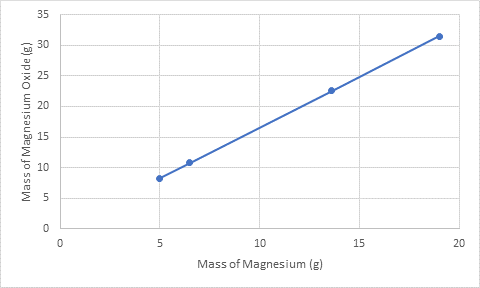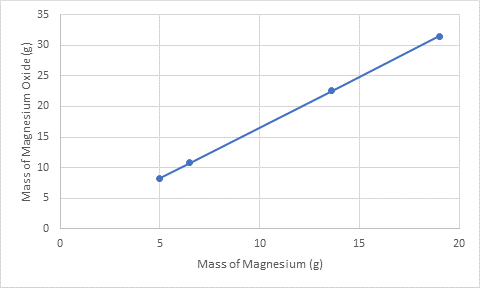
EP CHEMISTRY-ETEXT ACCESS
12th Edition
ISBN: 9780133204872
Author: WILBRAHAM
Publisher: SAVVAS L
expand_more
expand_more
format_list_bulleted
Question
Chapter 2, Problem 12STP
Interpretation Introduction
Interpretation: A graph must be plotted between the mass of magnesium on the x-axis and the mass of magnesium oxide on the y-axis for the given table.
Concept Introduction: In a chemical change, the
Expert Solution & Answer
Answer to Problem 12STP

Explanation of Solution
Given:
| Mass of Magnesium (g) | Mass of Oxygen (g) | Mass of magnesium oxide (g) |
| 5 | 3.30 | 8.3 |
| 6.5 | 4.30 | 10.8 |
| 13.6 | 9.00 | 22.60 |
| 19.00 | 12.50 | 31.5 |
According to the law of conservation of mass, mass is conserved in any chemical or physical change. The mass of reactants is always equal to the mass of products during any
On plotting the mass of magnesium on the x-axis and mass of magnesium oxide on the y-axis, the plot obtained is:

Chapter 2 Solutions
EP CHEMISTRY-ETEXT ACCESS
Ch. 2.1 - Prob. 1LCCh. 2.1 - Prob. 2LCCh. 2.1 - Prob. 3LCCh. 2.1 - Prob. 4LCCh. 2.1 - Prob. 5LCCh. 2.1 - Prob. 6LCCh. 2.1 - Prob. 7LCCh. 2.1 - Prob. 8LCCh. 2.1 - Prob. 9LCCh. 2.1 - Prob. 10SP
Ch. 2.1 - Prob. 11SPCh. 2.2 - Prob. 12LCCh. 2.2 - Prob. 13LCCh. 2.2 - Prob. 14LCCh. 2.2 - Prob. 15LCCh. 2.2 - Prob. 16LCCh. 2.2 - Prob. 17LCCh. 2.2 - Prob. 18LCCh. 2.2 - Prob. 19LCCh. 2.3 - Prob. 20SPCh. 2.3 - Prob. 21SPCh. 2.3 - Prob. 22LCCh. 2.3 - Prob. 23LCCh. 2.3 - Prob. 24LCCh. 2.3 - Prob. 25LCCh. 2.3 - Prob. 26LCCh. 2.3 - Prob. 27LCCh. 2.3 - Prob. 28LCCh. 2.3 - Prob. 29LCCh. 2.3 - Prob. 30LCCh. 2.3 - Prob. 31LCCh. 2.4 - Prob. 32LCCh. 2.4 - Prob. 33LCCh. 2.4 - Prob. 34LCCh. 2.4 - Prob. 35LCCh. 2.4 - Prob. 36LCCh. 2.4 - Prob. 37LCCh. 2.4 - Prob. 38LCCh. 2 - Prob. 39ACh. 2 - Prob. 40ACh. 2 - Prob. 41ACh. 2 - Prob. 42ACh. 2 - Prob. 43ACh. 2 - Prob. 44ACh. 2 - Prob. 45ACh. 2 - Prob. 46ACh. 2 - Prob. 47ACh. 2 - Prob. 48ACh. 2 - Prob. 49ACh. 2 - Prob. 50ACh. 2 - Prob. 51ACh. 2 - Prob. 52ACh. 2 - Prob. 53ACh. 2 - Prob. 54ACh. 2 - Prob. 55ACh. 2 - Prob. 56ACh. 2 - Prob. 57ACh. 2 - Prob. 58ACh. 2 - Prob. 59ACh. 2 - Prob. 60ACh. 2 - Prob. 61ACh. 2 - Prob. 62ACh. 2 - Prob. 63ACh. 2 - Prob. 64ACh. 2 - Prob. 65ACh. 2 - Prob. 66ACh. 2 - Prob. 67ACh. 2 - Prob. 68ACh. 2 - Prob. 69ACh. 2 - Prob. 70ACh. 2 - Prob. 71ACh. 2 - Prob. 72ACh. 2 - Prob. 73ACh. 2 - Prob. 74ACh. 2 - Prob. 75ACh. 2 - Prob. 76ACh. 2 - Prob. 77ACh. 2 - Prob. 78ACh. 2 - Prob. 79ACh. 2 - Prob. 80ACh. 2 - Prob. 81ACh. 2 - Prob. 82ACh. 2 - Prob. 83ACh. 2 - Prob. 84ACh. 2 - Prob. 85ACh. 2 - Prob. 86ACh. 2 - Prob. 87ACh. 2 - Prob. 88ACh. 2 - Prob. 89ACh. 2 - Prob. 90ACh. 2 - Prob. 93ACh. 2 - Prob. 94ACh. 2 - Prob. 95ACh. 2 - Prob. 1STPCh. 2 - Prob. 2STPCh. 2 - Prob. 3STPCh. 2 - Prob. 4STPCh. 2 - Prob. 5STPCh. 2 - Prob. 6STPCh. 2 - Prob. 7STPCh. 2 - Prob. 8STPCh. 2 - Prob. 9STPCh. 2 - Prob. 10STPCh. 2 - Prob. 11STPCh. 2 - Prob. 12STPCh. 2 - Prob. 13STPCh. 2 - Prob. 14STP
Knowledge Booster
Similar questions
- Which of the following is the product of the reaction between acetone, CH3COCH3 and methyl amine, CH3NH2? Why is the correct answer A? Please explain what is happening. Please include a detailed explanation and a drawing of steps needed to understand the reaction or question.arrow_forwardWhat is the product of the reaction shown below? Why is the correct answer D? Please explain what is happening. Please include a detailed explanation and a drawing of steps needed to understand the reaction or question.arrow_forwardWrite the systematic name of each organic molecule: structure name П O ☐ O ☐ Oarrow_forward
- The 13C NMR signal for which of the indicated carbons will occur at the frequency (most deshielded)? Why is the correct answer E? Please explain what is happening. Please include a detailed explanation needed to understand the or question.arrow_forwardWhich of the following reagents best achieves the reaction shown below? Why is the correct answer B? Please explain what is happening. Please include a detailed explanation and a drawing of steps needed to understand the reaction or question.arrow_forwardWhat is the product of the following reaction sequence? Why is the correct answer D? Please explain what is happening. Please include a detailed explanation and a drawing of steps needed to understand the reaction or question.arrow_forward
- Pls help ASAParrow_forwardThe reaction of phenylmagnesium bromide (C6H5MgBr) with propanal (CH3CH2CHO)3 followed by hydrolysis yields. A. 2-phenyl-1-propanol B. 1-phenyl-1propanol C. 3-phenyl-2-propanol D. 3-phenyl-1-propanol Why is the correct answer B? Please explain what is happening. Please include a detailed explanation and/or a drawing of steps needed to understand the reaction or question.arrow_forwardWhat is the product of the reaction sequence below? Why is the correct answer D? Please explain what is happening. Please include a detailed explanation and a drawing of steps needed to understand the reaction or question. The part that is under the pen in the image is (1) CH3CHO (2) H3O+arrow_forward
- What is the missing reactant in this organic reaction? R+ OH HD CH3-CH2-CH-CH3 H A CH3 CH3-CH2-C-O-CH-CH2-CH3 + H₂O Specifically, in the drawing area below draw the condensed structure of R. If there is more than one reasonable answer, you can draw any one of them. If there is no reasonable answer, check the No answer box under the drawing area. No answer Click anywhere to draw the first atom of your structure. ☐ : Jm +arrow_forwardDraw the major product of the following E2 reaction. Make sure you pay attention to REGIOCHEMISTRY and STEREOCHEMISTRY. Explain why this product is formed using 10 words or less for each. (a) NaH Br acetone TSO, NaH (b) acetonearrow_forward2. Circle the compound that will react SLOWER in an E2 reaction. To get credit for this question, you must EXPLAIN how you got your answer using STRUCTURES and WORDS. Br ** Br...arrow_forward
arrow_back_ios
SEE MORE QUESTIONS
arrow_forward_ios
Recommended textbooks for you
 ChemistryChemistryISBN:9781305957404Author:Steven S. Zumdahl, Susan A. Zumdahl, Donald J. DeCostePublisher:Cengage Learning
ChemistryChemistryISBN:9781305957404Author:Steven S. Zumdahl, Susan A. Zumdahl, Donald J. DeCostePublisher:Cengage Learning ChemistryChemistryISBN:9781259911156Author:Raymond Chang Dr., Jason Overby ProfessorPublisher:McGraw-Hill Education
ChemistryChemistryISBN:9781259911156Author:Raymond Chang Dr., Jason Overby ProfessorPublisher:McGraw-Hill Education Principles of Instrumental AnalysisChemistryISBN:9781305577213Author:Douglas A. Skoog, F. James Holler, Stanley R. CrouchPublisher:Cengage Learning
Principles of Instrumental AnalysisChemistryISBN:9781305577213Author:Douglas A. Skoog, F. James Holler, Stanley R. CrouchPublisher:Cengage Learning Organic ChemistryChemistryISBN:9780078021558Author:Janice Gorzynski Smith Dr.Publisher:McGraw-Hill Education
Organic ChemistryChemistryISBN:9780078021558Author:Janice Gorzynski Smith Dr.Publisher:McGraw-Hill Education Chemistry: Principles and ReactionsChemistryISBN:9781305079373Author:William L. Masterton, Cecile N. HurleyPublisher:Cengage Learning
Chemistry: Principles and ReactionsChemistryISBN:9781305079373Author:William L. Masterton, Cecile N. HurleyPublisher:Cengage Learning Elementary Principles of Chemical Processes, Bind...ChemistryISBN:9781118431221Author:Richard M. Felder, Ronald W. Rousseau, Lisa G. BullardPublisher:WILEY
Elementary Principles of Chemical Processes, Bind...ChemistryISBN:9781118431221Author:Richard M. Felder, Ronald W. Rousseau, Lisa G. BullardPublisher:WILEY

Chemistry
Chemistry
ISBN:9781305957404
Author:Steven S. Zumdahl, Susan A. Zumdahl, Donald J. DeCoste
Publisher:Cengage Learning

Chemistry
Chemistry
ISBN:9781259911156
Author:Raymond Chang Dr., Jason Overby Professor
Publisher:McGraw-Hill Education

Principles of Instrumental Analysis
Chemistry
ISBN:9781305577213
Author:Douglas A. Skoog, F. James Holler, Stanley R. Crouch
Publisher:Cengage Learning

Organic Chemistry
Chemistry
ISBN:9780078021558
Author:Janice Gorzynski Smith Dr.
Publisher:McGraw-Hill Education

Chemistry: Principles and Reactions
Chemistry
ISBN:9781305079373
Author:William L. Masterton, Cecile N. Hurley
Publisher:Cengage Learning

Elementary Principles of Chemical Processes, Bind...
Chemistry
ISBN:9781118431221
Author:Richard M. Felder, Ronald W. Rousseau, Lisa G. Bullard
Publisher:WILEY